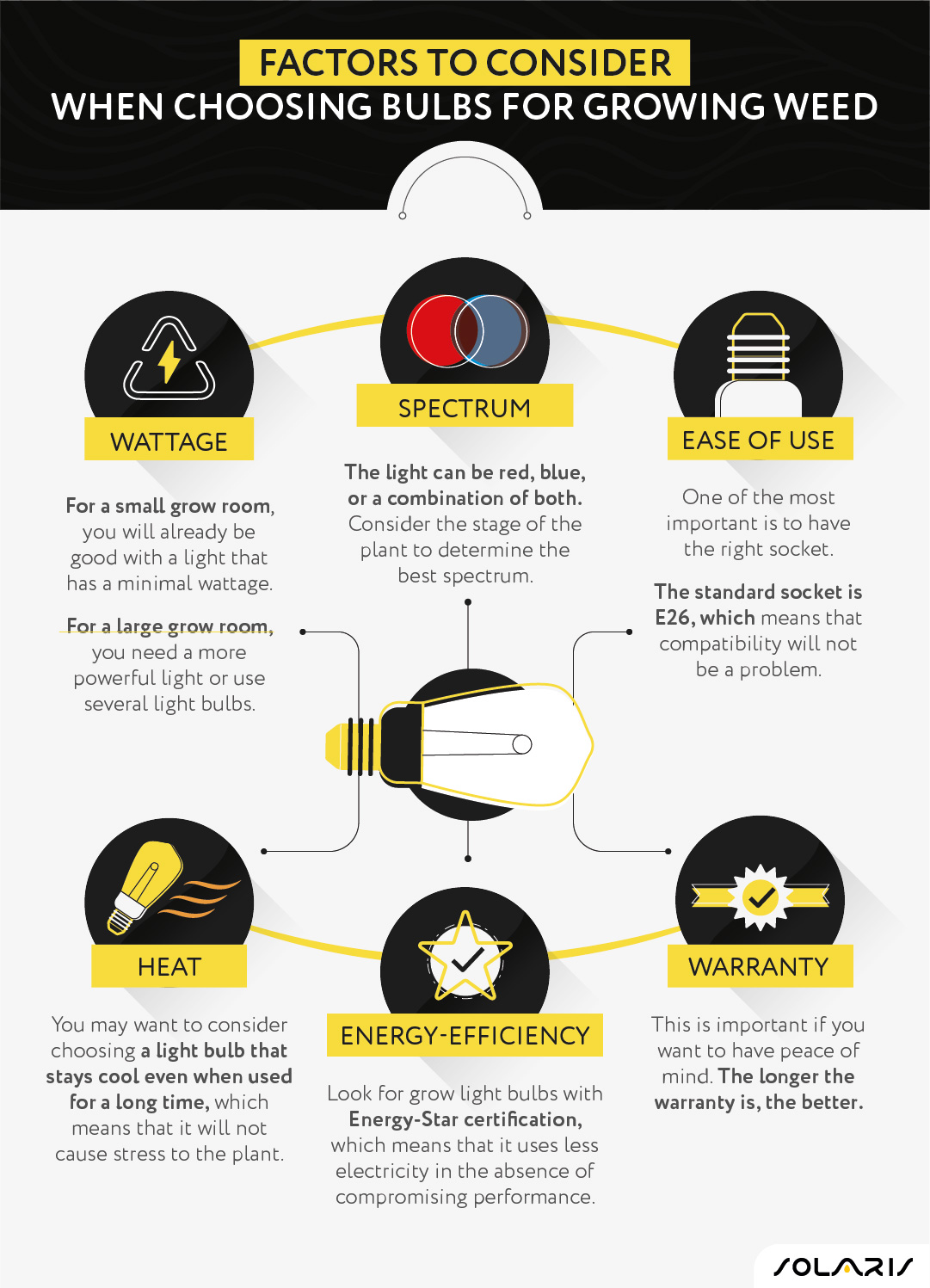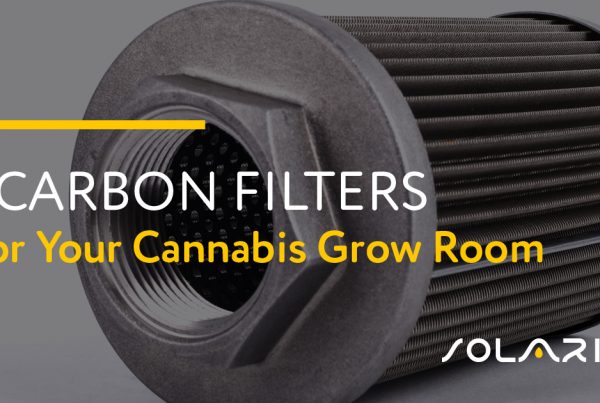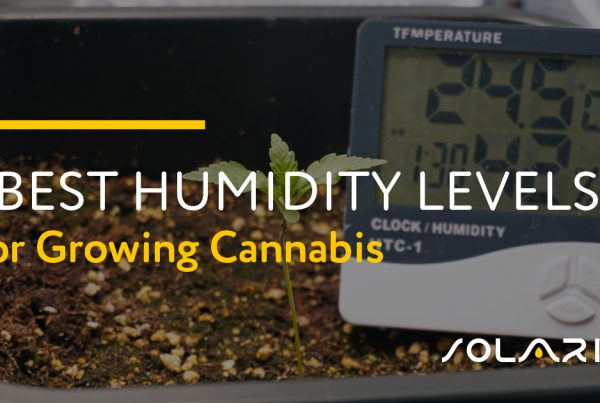One of the crucial elements a cannabis plant needs is light. During photosynthesis, a plant converts light energy into chemical energy, allowing it to grow strong and healthy, and with cannabis, in particular, light also fuels bud production.
When growing outdoors you can harness the power of the sun, but in an indoor environment, sunlight is mimicked through the use of grow lights, which aim to display the same spectrum of light as the sun.
Some grow lights are more expensive than others, but also more efficient, saving money in the long run. Some lights are bulky with many parts, some light in weight, and some are better suited for young or mature plants.
There are many different kinds of lights out there, so it can be daunting to know where to begin. People often assume you need expensive grow lights to make up for the lack of natural light, but they are wrong. You can indeed use regular light bulbs to grow plants indoors.
Do standard light bulbs work for a grow?
Incandescent lights are the standard light bulbs we all already have in our homes. They may be the cheapest option, but they are inefficient for growing cannabis.
They use more power to get the same output and they give off a substantial amount of heat. For these reasons, it is generally not recommended to use them for your weed plants.
If you do use incandescent bulbs, make sure you do not place them too close to the plants. Use the hand test. Place the back of your hand where the plant is and wait a minute. If the light becomes too hot for your hand, it is also too hot for the plant and you need to move it further away.
Fluorescent lights for growing cannabis
Fluorescent grow lights come in many different shapes and sizes, from twisty bulbs to long tubes. Fluorescents are popular because they make efficient and pleasant lighting for humans and also work great for herb gardens and indoor cannabis grows without using a lot of electricity.
CFL (compact fluorescent lamps) grow lights are the twisty-looking bulbs you can find anywhere you normally buy light bulbs. They produce a great spectrum for growing cannabis and can be used in tiny spaces where no other grow light would fit such as the inside of a cabinet.
T5 fluorescent grow lights are one of the most easily available types of grow lights and are used to grow many different types of plants. As a result, they are available in many garden and home improvement stores.
T5s are much bigger and wider than CFLs and usually come as part of a panel, but they can still be kept mere inches away from your plants without worrying about burning them. The “T” stands for “tubular” and the “5” refers to its diameter of “⅝ of an inch.”
Fluorescents are a great choice for clones, young plants, supplemental lighting and can save you money on electricity in the vegetative stage compared to using high power lights when plants are too young to use it all anyway.
HID lights for growing cannabis
HID (high-intensity discharge) is an umbrella term under which MH (metal halide), HPS (high-pressure sodium), and LEC (light-emitting ceramic) bulbs fall. These types of lamps have a hood that reflects light and bulbs that are enclosed capsules containing gas, as opposed to bulbs you would find in your house, which have a filament that heats up.
You can find HID reflector hoods, as well as MH, HPS, and LEC bulbs at any local grow shop. Here is a further in-depth look at these lights.
- MH (metal halide): These bulbs contain mercury and metal halides, produce a blueish light, and are commonly used for vegetative growth. They require a ballast to regulate the current. In the past, ballasts have been big and bulky, but digital ones are now available.
- HPS (high-pressure sodium): These HID bulbs usually contain sodium, mercury, and xenon, and produce a yellow/orange light, and are commonly used for flowering plants. Some growers will start plants under MH bulbs and switch them to HPSs when plants go into the flowering stage, using the same hood. These lights also require a ballast.
- LEC (light-emitting ceramic) aka CMH (ceramic metal halide): These are just two names for the same thing. This type of metal halide bulb uses ceramic as part of the lamp just like an HPS. As a result, CMH bulbs are more efficient than regular MH lights (though still not as efficient as HPS bulbs). “LEC” and “CMH” both refer to ceramic metal halide grow lights, which is a type of HID light that is a bit more efficient than a regular Metal Halide light
HIDs have been the standard in indoor weed growing for decades, but LEDs are quickly catching up to them. All types of HIDs are usually inexpensive to buy but will eat up electricity. HIDs throw off a lot of light and heat, which the plants need to bulk up and get potent.
On the downside, they run hot, contain heavy metals, and ballasts can fail. However, because of their low price, if you are new to indoor growing and not sure how often you will do it, you may want to invest in an inexpensive HID light initially to get a feel for the whole process.
LED lights for growing cannabis
LED grow lights are very popular among cannabis growers. They tend to run cooler than other common grow lights, thanks to their built-in cooling capabilities.
They can often be plugged into a wall and simply hung over plants which are easier than setting up an HID grow light. LEDs also have great penetration so they do not need to be moved frequently like fluorescents.
For growers who are looking to harvest 1/2 to 1 ounce of cannabis a month, LEDs may be your best choice. At this size, they are super low on electricity, run cool, and need almost no setup. They get better yields than fluorescents but do not run as hot as an HID of similar wattage.
LED vs. CFL vs. HID grow light bulbs
LED, CFL, and HID are the three most common grow lights. Here is a quick breakdown of the similarities and the differences between the three.
- LED grow bulbs: It is the most energy-efficient of the three commonly available types. They also remain cool even when left turned on for an extended period. The initial cost of acquiring LED, on the other hand, can be quite steep for some users.
- CFL grow bulbs: Compact Fluorescent Lighting bulbs are cheaper, but they are also less powerful when compared to the other two types. It is known for generating a minimal amount of heat, which makes it a great choice when starting the plant. If you are looking for the best light bulb for clones, CFL will be an unmatched choice.
- HID grow bulbs: They are a favorite amongst weed cultivators because of the amount of usable light that they can produce. The growth rate is also the fastest with this light bulb. However, you will need a special type of ballast and hood for this type.
Types of grow light bulb sockets
It is important to be familiar with the different sockets or bases that are available. The end of the light bulb must perfectly fit on the base when it is screwed. In this case, these are the available options:
- E12: Also known as the candelabra, this is the smallest screw base for a grow light bulb. This also tends to be weak, making it great only for clones or for seedlings.
- E17: This is a size that is popular in Europe and China. As with the other bulbs that are mentioned in this guide, “E” stands for Edison while the number stands for the millimeter of the base of the light.
- E26: This is the standard size of the light bulb socket, which makes it the most popular in North America. In Europe, its equivalent is the E27. Aside from grow rooms, it has a wide array of applications, such as general lighting fixtures at home.
- E39: The E39 is used in North America and the E40 is in Europe. They can be used interchangeably as there is only a 1mm difference. If you need grow light bulbs with a powerful output, this is what you should choose.
Factors to consider when choosing bulbs for growing weed

When choosing from the products that are available on the market, here are some of the most important things that you need to take into consideration:
- Wattage: You need to consider the size of the grow room and the plants that are inside to determine the right wattage of the light bulb to buy. For a small grow room with only one or a few plants, you will already be good with a light that has a minimal wattage. If the grow tent is large, you need a more powerful light or use several light bulbs.
- Spectrum: More often than not, the light can be red, blue, or a combination of both. Consider the stage of the plant to determine the best spectrum.
- Ease of use: For the light bulb to be user-friendly, one of the most important is to have the right socket. The standard socket is E26, which means that compatibility will not be a problem. In some cases, you need to install a new socket that will fit the light that you will be using.
- Heat: When choosing the best bulbs for growing plants indoors, you also need to think about the amount of heat that they can generate. You may want to consider choosing a light bulb that stays cool even when used for a long time, which means that it will not cause stress to the plant. Also, pay attention to the height of the light when it is installed.
- Energy-efficiency: This is important if you have a large grow room, especially if you are a commercial cultivator. Look for grow light bulbs with Energy-Star certification, which means that it uses less electricity in the absence of compromising performance.
- Warranty: This is important if you want to have peace of mind. The longer the warranty is, the better. This means that if it becomes defective, under the terms and conditions of the manufacturer, they can have it repaired or replaced.
Lighting terms you should know
There is plenty of terminology to learn in order to better understand lights. Here are some important terms to know:
Light spectrum
Regular (photoperiod) cannabis plants require different spectrums of light to produce flower. Blue spectrum light is needed during the vegetative stage, while red spectrum light is needed to transition to the flowering stage. However, if you start with autoflowering plants, you will not need to change the lighting to start the flowering stage, so the light spectrum is less of a concern.
For all types of cannabis, it is usually a good idea to purchase lighting that has both blue and red light spectrums. With regular plants, it saves you from the hassles and costs associated with changing the lighting to induce flowering. LED lights have a full spectrum of light, so you can use the same lights from seedling to harvest.
Wattage
Wattage refers to a light’s power rating. Pay attention to this number because it has a bearing on how many lights you will need. For example, if you have a smaller grow space, one light with high wattage may be enough. However, if the lighting you choose has low wattage, you will need additional lights to provide the proper coverage.
Wattage also helps determine how far away you should keep your plants. Generally speaking, higher wattage lights need to be positioned further away from your plants because they can burn them. LED lights are an exception to this rule because they give off surprisingly less heat when compared to the other types of lighting with the same wattage.
Lumens
Lumens is a measure of how much light a given light source emits during each second the light is on. Like the light spectrum, lumens are more relevant for photoperiod plants. Regular cannabis plants require varying amounts of lumens during the different stages of growth. For example, they need between 2,500 and 5,000 lumens per square foot in the vegetative phase, but it jumps to 10,000 lumens per square foot during the flowering phase.
That is why it is a good idea to assess the lumen measurement when considering lights for growing weed. Cannabis plants need lights that provide enough lumens intensity for their proper growth.
Kelvin
The kelvin is the base unit of temperature in the International System of Units, having the unit symbol K. Kelvin refers to the warmth and color of the light being emitted. During the vegetative stage, cannabis thrives best when provided cool daytime blue light with approximately 6,400 kelvin. Conversely, flowering cannabis performs best with a warmer red light of 2,700 kelvin.
How to determine the wattage of light required to grow
The wattage of light that you require for growing weed depends on two things: How many plants you are growing and the size of your grow space.
Each cannabis plant requires at least 1 square foot of space to grow in. This allows the plant room to grow to its full potential without being impeded by the plants around it. For LED and HID grow lights, the minimum recommended wattage per square foot of space is 50w. It jumps up to 150w for fluorescent lights.
Therefore, to calculate the wattage you require, you need to calculate the square foot of your grow space and multiply it by 50 or 150 depending on the type of light you have.


